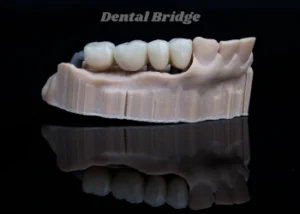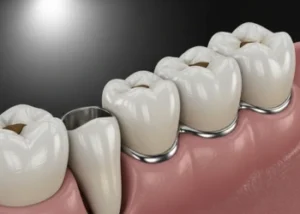
A bright smile boosts your confidence, especially during Chicago’s chilly winter months when dry air can challenge oral health. If you’ve lost a tooth, a dental bridge offers a reliable way to fill the gap. At EliteFixDenture.com, we prioritize your comfort and long-term smile health in neighborhoods like Lincoln Park and Lakeview.
What Is a Dental Bridge?
You bridge the gap—literally—with a dental bridge. This prosthetic device replaces one or more missing teeth. It anchors to the healthy teeth on either side, called abutments, and features a false tooth, or pontic, in the middle.
Dentists craft bridges from durable materials like porcelain or metal alloys to mimic natural teeth. They restore your ability to chew, speak, and smile without hesitation.
Types of Dental Bridges
Choose the right type based on your oral health and location of the missing tooth. Here are the main options:
| Type | Description | Best For |
| Traditional | Pontic supported by crowns on adjacent teeth on both sides. | Most common for back teeth. |
| Cantilever | Pontic attached to one adjacent tooth. | Front teeth with strong support. |
| Maryland (Resin-Bonded) | Pontic with metal or porcelain wings bonded to the back of adjacent teeth. | Front teeth in younger patients. |
| Implant-Supported | Pontic secured by dental implants instead of natural teeth. | Multiple missing teeth or weak abutments. |

Who Might Need a Dental Bridge?
Missing teeth affect more than appearance—they shift your bite and strain remaining teeth. You may need a bridge if decay, injury, or disease has caused tooth loss.
Early intervention prevents bone loss and gum issues. In Chicago’s Lakeview area, where active lifestyles thrive, bridges keep you smiling through winter runs and holiday gatherings.
Dr. Aziz Liaquat, our implant dentistry specialist, often recommends bridges for patients seeking durable restorations like dentures or extractions follow-ups.
The Dental Bridge Procedure
We make the process smooth and painless. Expect two visits over a few weeks.
Preparation Visit
Your dentist examines your mouth and takes X-rays. They prepare abutment teeth by reshaping them for crowns. Impressions guide the lab in creating your custom bridge. You wear a temporary one meantime.
Placement Visit
We fit the permanent bridge, adjust for comfort, and bond it securely. Bite checks ensure even pressure.
Benefits of a Dental Bridge
Bridges transform daily life. Key advantages include:
- Restored Function: Chew favorite foods without worry.
- Enhanced Appearance: Match your natural smile seamlessly.
- Oral Health Protection: Prevent adjacent teeth from drifting and maintain jawbone density.
- Durability: Last 5–15 years with proper care.
In Lincoln Park’s vibrant community, a confident smile shines at every café stop.
For more on tooth replacement options, visit the American Dental Association’s guide on bridges.
Potential Risks and How to Avoid Them
No procedure is risk-free, but we minimize concerns. Possible issues include decay under crowns or gum irritation.
Avoid risks with excellent hygiene and biannual checkups. Chicago’s dry winter air heightens sensitivity—stay hydrated and use a humidifier at home.
Caring for Your Dental Bridge
Treat your bridge like natural teeth. Brush twice daily with a soft toothbrush and floss daily to clean under the pontic.
Avoid hard foods that could crack it. Schedule cleanings to catch issues early. With diligence, your bridge supports your smile for years.

FAQs: Dental Bridges
Q: How long does a dental bridge last?
A: Most bridges endure 5–15 years, depending on care and oral health.
Q: Does getting a dental bridge hurt?
A: Local anesthesia keeps you comfortable. Mild soreness may follow, but it fades quickly.
Q: Can anyone get a dental bridge?
A: Healthy abutment teeth are key. We assess during consultation.
Q: What’s the difference between a bridge and an implant?
A: Bridges use adjacent teeth; implants use posts in the jawbone for independence.
Q: How much does a dental bridge cost?
A: Expect $2,000–$5,000 per bridge, varying by type and materials.
Q: Can I eat normally after placement?
A: Yes, once adjusted. Start soft, then enjoy all foods.
Q: Do bridges affect speech?
A: Rarely—your tongue adapts quickly.
Q: How do I clean under a dental bridge?
A: Use floss threaders or water flossers for thorough cleaning.
This content is informational only and not a substitute for professional dental advice. Consult your dentist for personalized guidance.
For expert dental care in Chicago, visit EliteFixDenture.com.





